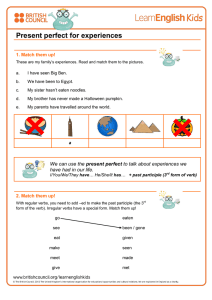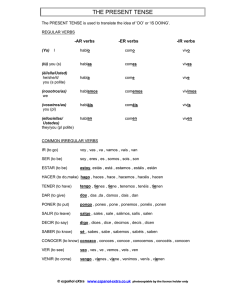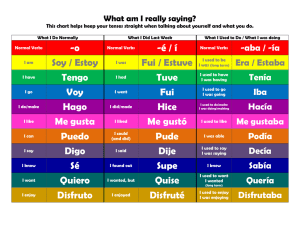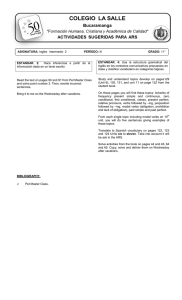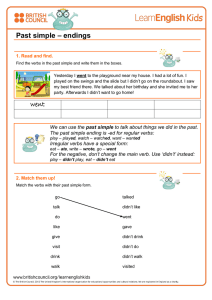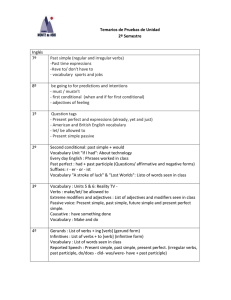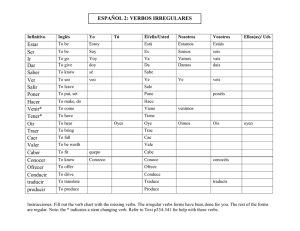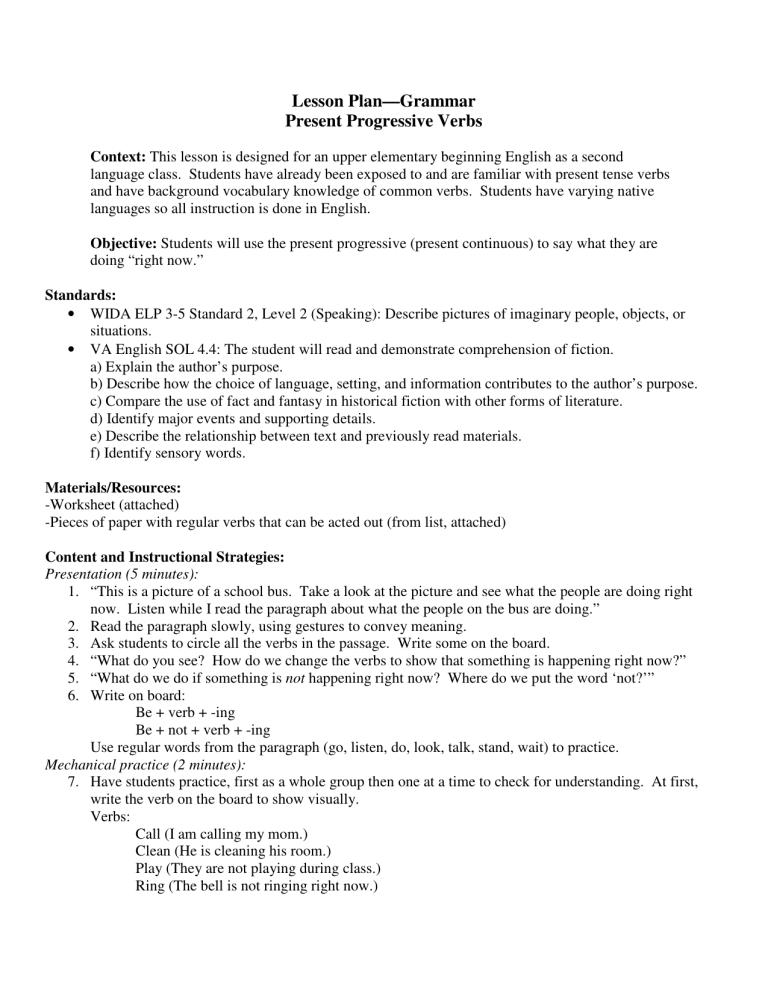
Lesson Plan—Grammar Present Progressive Verbs Context: This lesson is designed for an upper elementary beginning English as a second language class. Students have already been exposed to and are familiar with present tense verbs and have background vocabulary knowledge of common verbs. Students have varying native languages so all instruction is done in English. Objective: Students will use the present progressive (present continuous) to say what they are doing “right now.” Standards: • WIDA ELP 3-5 Standard 2, Level 2 (Speaking): Describe pictures of imaginary people, objects, or situations. • VA English SOL 4.4: The student will read and demonstrate comprehension of fiction. a) Explain the author’s purpose. b) Describe how the choice of language, setting, and information contributes to the author’s purpose. c) Compare the use of fact and fantasy in historical fiction with other forms of literature. d) Identify major events and supporting details. e) Describe the relationship between text and previously read materials. f) Identify sensory words. Materials/Resources: -Worksheet (attached) -Pieces of paper with regular verbs that can be acted out (from list, attached) Content and Instructional Strategies: Presentation (5 minutes): 1. “This is a picture of a school bus. Take a look at the picture and see what the people are doing right now. Listen while I read the paragraph about what the people on the bus are doing.” 2. Read the paragraph slowly, using gestures to convey meaning. 3. Ask students to circle all the verbs in the passage. Write some on the board. 4. “What do you see? How do we change the verbs to show that something is happening right now?” 5. “What do we do if something is not happening right now? Where do we put the word ‘not?’” 6. Write on board: Be + verb + -ing Be + not + verb + -ing Use regular words from the paragraph (go, listen, do, look, talk, stand, wait) to practice. Mechanical practice (2 minutes): 7. Have students practice, first as a whole group then one at a time to check for understanding. At first, write the verb on the board to show visually. Verbs: Call (I am calling my mom.) Clean (He is cleaning his room.) Play (They are not playing during class.) Ring (The bell is not ringing right now.) Sing (We are singing.) Hang (The clothes are hanging in the closet.) Drink (I am drinking water.) Think (I am not thinking about the weekend.) Catch (You are catching the ball.) Feed (He is feeding his dog.) 8. Reinforce that we use the –ing form to talk about something that is happening right now. Explain that there are other uses that they will learn later. Meaningful practice (3 minutes): 9. “Look at the other picture on the page. Write at least three things that are happening or not happening right now in the classroom.” 10. Have several volunteers read one of the sentences they wrote. Open-ended practice (5 minutes): 11. “We are going to play a game that talks about what is happening right now. It is called ‘charades.’ You have to pick out a piece of paper and act out what is happening.” Demonstrate. “People guessing will have to say what they are doing right now in a sentence. 12. Play charades at least until each student has had a chance to act and to form a meaningful sentence in the present progressive. Evaluation: During practices, informally assess each student’s level of understanding and competence. Adjust instruction accordingly. Differentiation and Adaptations: This lesson is designed for novice language users who have little prior knowledge of the language and no exposure to the present progressive. If some students have prior knowledge of the language, they can serve as facilitators for those who do not. Reflection: What I liked about this lesson: • I think I came up with appropriate but engaging activities that allowed the students to use the present progressive meaningfully but in a controlled way. • The students seemed to enjoy charades. • I planned all of the example verbs I would use ahead of time so that I did not accidentally use irregulars. What I would change about this lesson: • I used the present progressive during my instructions before having taught it. • I need to think through how to give instructions in a way that is comprehensible to ELLs. Mine were much too complicated. • Although I planned example sentences ahead of time for the mechanical practice, I need to think through the examples more carefully. Some of the students seemed confused. • I should have used an existing present progressive worksheet instead of making my own. My paragraph did not seem very native sounding. • I should have waited to introduce negation in a subsequent lesson. There was too much to cover during a limited amount of time, and my students should have had more time to practice. • I should have pointed out the irregular verbs in the paragraph and explained that we would learn about them later to avoid confusing students. • I think my students would have learned more clearly if I had taught them deductively instead of inductively. I wanted to try the inductive approach but it seemed too confusing for the students, especially with such limited time for the lesson. • The students needed more opportunities to respond chorally and individually. I spoke too much and they did not speak enough. Present Progressive: Happening Right Now Right now, people on the bus are going to school. The driver is looking in the mirror to see behind him. Passengers are riding the bus. One man is standing, but most people are sitting. One girl is looking at her friend. Another woman is listening to music on her headphones. The passengers are not talking to each other. Some people are looking out the window, but most people are not doing anything. They are waiting to get to school. Using the following verbs, write at least three sentences about what is happening or not happening right now in the classroom. Go Do Look Listen Stand Talk Wait Walk Call Play Drink Think Teach Sleep Meet Lend Feel Dream Ex. The teacher is standing at the front of the room. Hold Tell Know Throw Show Eat Wear Say Read Verbs for charades: To call To catch To clean To draw To dream To drink To eat To fall To feel To fly To grow To hang To hold To look To meet To play To read To sew To shoot To sing To sleep To steal To talk To teach To tell To think To throw To walk
